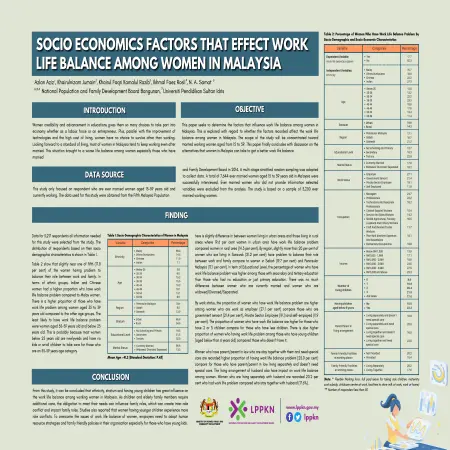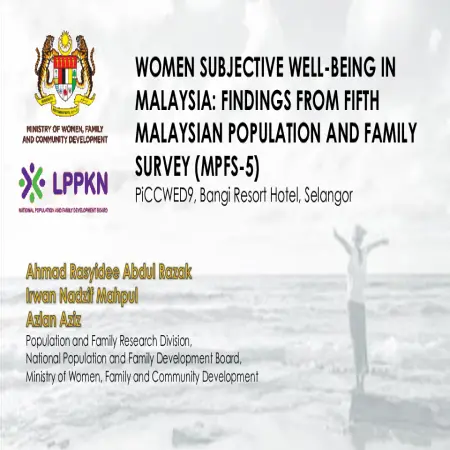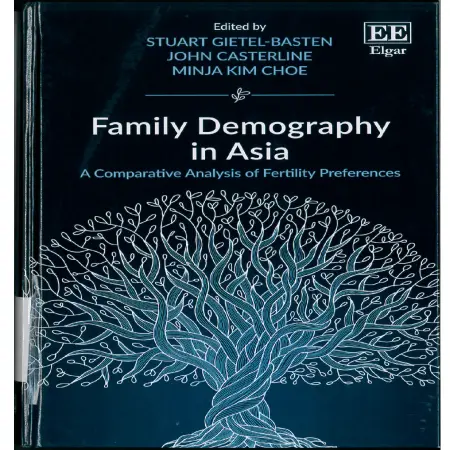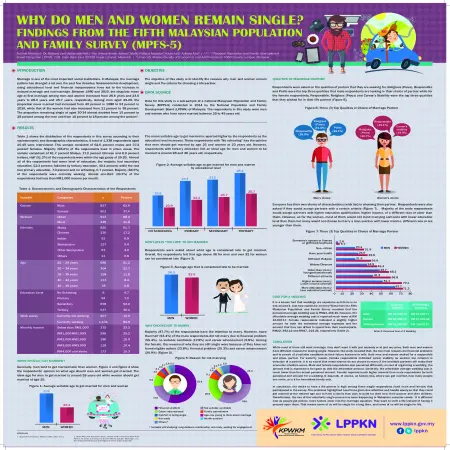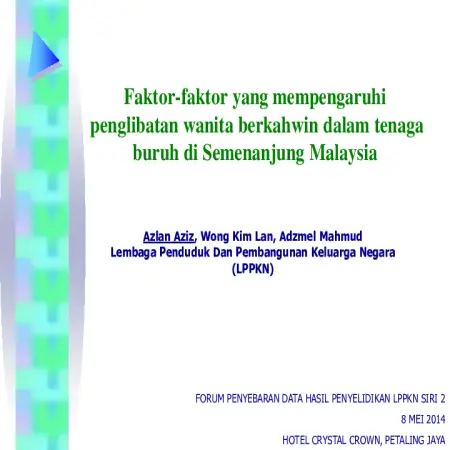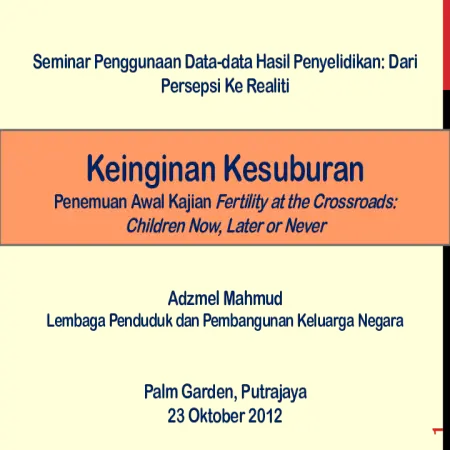Browse by Author
Results for Family Name : "Aziz" AND Given Name/Initial : "Azlan"
|
|
Socio economics factors that effect work life balance among women in Malaysia
Item Type: Scientific Poster
Editor:
Year: 00/00/2021
Abstract: This paper seeks to determine the factors that influence work life balance among women in Malaysia. This is explored with regard to whether the factors recorded affect the work life balance among women in Malaysia. The scope of the study will be concentrated toward married working women aged from 15 to 59. This paper finally concludes with discussion on the alternatives that women in Malaysia can take to get a better work life balance.
|
|
|
|
|
|
Women subjective well-being In Malaysia: findings from Fifth Malaysian Population and Family Survey (Mpfs-5)
Item Type: Article
Editor:
Year: 00/10/2019
Abstract: The subjective well-being is defined as one's cognitive and affective assessment of a person's life (Diener, Lucas & Oshi, 2002). This article aims to measure the subjective well-being of women between age 20 to 59 years old in Malaysia. For measurement purposes, this article has adopted the Personal Well-being Index (PWI) instrument developed by the International Wellbeing Group.
|
|
|
|
|
|
Women subjective well-being in Malaysia: findings from Fifth Malaysian Population and Family Survey (MPFS-5)
Item Type: Conference or Workshop Item
Editor:
Year: 00/00/2019
Abstract: This presentation slide aims to measure the subjective well-being of women between age 20 to 59 years old in Malaysia. A total of 8, 171 respondents in the Fifth Malaysian Population and Family Survey (MPFS-5) with different marital status, employment status, ethnic and strata who answered the PWI instrument were analyzed.
|
|
|
|
|
|
Fertility preferences in Malaysia
Item Type: Book Section
Editor:
Year: 30/11/2018
Abstract: Most countries have been experiencing changes in fertility pattern over the last few decades. Fertility transition from high to low is a relatively recent phenomenon in Malaysia. The total fertility rate (TFR) had declined from 4.9 children per woman in 1970 to 4.0 in 1980. It has continued to fall and has reached the replacement level of 2.1 in 2010. This chapter provides the trend analysis and a comparative analysis of fertility trends to explain the fertility transition of Malaysia’s population. Data used in this study were obtained from Department of Statistics, Malaysia and Fifth Malaysian Population and Family Survey, 2014. The result of this study showed that the fertility rate between age groups was higher among Malay than other ethnics since 1991–2010. Across all ages, the fertility rate has a negative correlation with the educational level where women with tertiary education tend to have fewer children compared to less educated women. This study also presents the fertility desire in Malaysia. There is a negative correlation between age group and fertility desire. In addition, the desire to stop childbearing is found to be stronger when women have had three living children. The findings of this study will help policy makers to plan programmes to improve the fertility rate in Malaysia.
|
|
|
|
|
|
Why do men and women remain single? Findings from the Fifth Malaysian Population and Family Survey (MPFS-5)
Item Type: Scientific Poster
Editor:
Year: 01/07/2015
Abstract: Marriage is one of the most important social institutions. In Malaysia, the marriage pattern has changed a lot over the past few decades. Socioeconomic development, rising educational level and financial independence have led to the increase in delayed marriage and non-marriage. Between 1980 and 2010, the singulate mean age at first marriage among men and women increased from 26.6 years and 23.5 years to 28.0 years and 25.7 years, respectively. Among men aged 25-29, the proportion never married had increased from 40 percent in 1980 to 53 percent in 2010, while that of the women had also increased from 21 percent to 38 percent. The proportion remaining single at aged 30-34 almost doubled from 15 percent to 28 percent among the men and from 10 percent to 18 percent among the women. The objective of this study is to identify the reasons why men and women remain single and the criteria for choosing a life partner.
|
|
|
|
|
|
Faktor-faktor yang mempengaruhi penglibatan wanita berkahwin dalam tenaga buruh di Semenanjung Malaysia
Item Type: Conference or Workshop Item
Editor:
Year: 00/00/2014
Abstract: This study is to identify the influences of socio-economic factors towards the labour force participation among married women in Peninsular Malaysia. Bivariate correlations and logistic regression analysis was applied to the data set containing 2,366 married women aged 15-49 years, interviewed during the Fourth Malaysian Population and Family Survey, 2004. It was found that only half of the women were currently working. Chinese had the highest percentage who were currently working as compared to the Malays and Indians. The logistic statistical analysis had also identified several variables which were important determinants of the current work status of married women. Based on logistic statistical analysis, it was found that stratum, previous occupation prior to marriage and presence of young children had significant relationships to women’s participation in the labour force.
|
|
|
|
|
|
Socio-economic determinants of pap smear screening among married women in Peninsular Malaysia
Item Type: Article
Editor:
Year: 00/02/2013
Abstract: This study is to identify the influences of socio-economic factors towards the practice of Pap smear screening among ever married women. Bivariate correlations and logistic regression analysis was applied to the data set containing 3,283 ever married women age 15-49 years, interviewed during the Fourth Malaysian Population and Family Survey, 2004. It was found that only half the women had undergone Pap smear screening prior three years of survey, in which Chinese had the highest percentage of Pap smear screening. The logistic statistical analysis also had identified several variables has important determinant has of Pap smear screening for ever married women. Finding from this study suggest a significant relationship between the cervical cancer awareness and knowledge, age and ethnicity for those women who practice Pap smear screening.
|
|
|
|
|
|
Keinginan kesuburan
Item Type: Conference or Workshop Item
Editor:
Year: 00/00/2012
Abstract: The decline in fertility rates in Malaysia is happening rapidly and it is expected that the rate will reach the replacement level (replacement level = 2.1) in 2015. A woman's desire/decision to have a child has a direct impact on the fertility rate and population growth. Thus, the study aims to identify the factors that influence women's desire to have children or do not need to be implemented. Data and Methodology: This paper presents the preliminary findings of the study Fertility at the Crossroad: Children Now, Later or Never conducted by LPPKN in 2012. This study uses a cross -sectional survey design method with a focus on women in the reproductive age group. 15-49 years working in the public sector in Kuala Lumpur, Putrajaya and Selangor. The method of data collection was through face -to -face interviews and self -administered using a questionnaire. Through stratified sampling method, a total of 98 public sector agencies were selected. To achieve the objectives of the study, the data obtained were analyzed using Descriptive Statistics, Chi Square and Logistic Regression (Forward LR Method). The dependent variable studied was the desire to have children (0 = do not want more children, 1 = want more children). While there are nine (9) independent variables studied namely age, ethnicity, education level, job grade (Management and Professional/Support), income, number of childbirths, pregnancy history (miscarriage/stillbirth/abortion), fertility problems and The husband lives far away. Findings: In total, a total of 1,898 data for women working in the public sector were analyzed. A total of 75.9% of respondents have a desire to have children. The results of Chi -Square analysis showed that the variables of age, ethnicity, income, number of births, pregnancy history, fertility problems and husbands living far apart had a significant relationship with the desire to have children. However, there is no evidence to suggest that post grade has a relationship with childbearing desire. Logistic regression test (Forward LR Method) showed that 57.8% of the variation in women's desire to have children can be explained by four independent variables, namely fertility problems, ethnicity, age and number of births. Conclusion: The results of the study found that women's desire to have children can be considered high. To support women's desire to have children, various forms of assistance/support should be provided by the employer/government. Among the main assistance/support needed are childcare centers at work, holiday facilities to care for sick children, subsidized childcare costs and full-paid facilities for children in need of special care.
|
|
|
|





